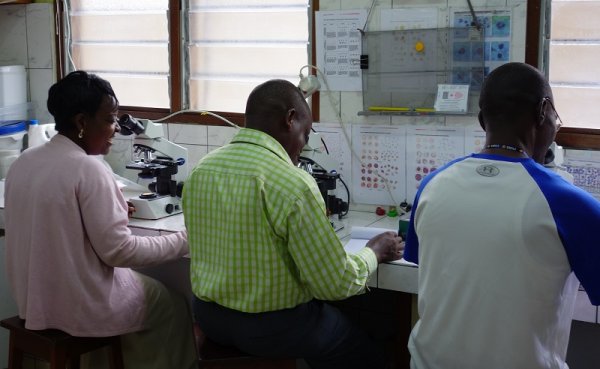Microscopy standards to harmonise methods for malaria clinical research studies
Research Malaria Microscopy Standards (ReMMS) applicable to malaria clinical research studies have been published in Malaria Journal. The paper describes the rationale for proposed standards to prepare, stain and examine blood films for malaria parasites.

The standards complement the methods manual previously published by the World Health Organization and UNICEF/UNDP/World Bank/WHO Special Programme for Research and Training in Tropical Diseases (TDR). The standards aim to promote consistency and comparability of data from microscopy performed for malaria research and hence to strengthen evidence for improvements in malaria prevention, diagnostics and treatment.
Microscopy is important in both malaria diagnosis and research. It is used to differentiate between Plasmodium species and stages and to estimate parasite density in the blood – an important determinant of the severity of disease. It is also used to monitor the effectiveness of drugs based on the rate at which parasites recrudesce or are cleared from the blood.
While rapid diagnostic tests have replaced microscopy in some contexts, microscopy remains an essential tool to support clinical diagnosis and research. Other existing guidelines and procedures for clinical microscopy are an excellent resource, but do not adequately address the more stringent requirements for malaria microscopy in research.
In a new paper in Malaria Journal, researchers describe comprehensive standards for undertaking and reporting microscopy in the context of research for malaria parasite detection, identification and quantification. These are complemented by a methods manual and the Obare calculator to aid standardisation in microscopy methods. The standards have been developed by the ReMMS Working Group, a panel of experts convened by TDR and are freely available to the research community.
The standardisation of methods allows direct comparisons from studies conducted across different points in time and location. This facilitates individual participant data meta-analyses, recognised as the gold standard approach to generate evidence for improvements in interventions and hence patient outcomes.
Dr Mehul Dhorda, Head of WWARN's Asia-Pacific Regional Centre, who led the work says: "Along with the members of the ReMMS Working Group, we extensively reviewed existing methods and standards for malaria microscopy with an aim to generate a coherent set of standards and procedures for research. We hope they will be adopted by research groups, especially in malaria endemic regions where research is most needed, as an aid for quality improvement and harmonisation."
The standards and manual include information and resources on:
Personnel
- Recommended slide sets and certification grades for competence testing
Equipment and materials
- Lists of recommended equipment and materials
Preparing blood films
- Guidance on specimen collection, labelling of slides
- Template for preparation of slides with thick and thin blood films
Blood film interpretation
- Procedural adjustments to harmonise limits of parasite detection and to improve accuracy and precision of parasite density estimates
Quality assurance
- Definitions of concordant results, tolerance limits for parasite density estimates
- Recommendations on numbers or proportions of slides to be rechecked for IQC, EQC
Recording and reporting microscopy results
- Data recording format for malaria microscopy data
- Suggested minimum requirements for reporting microscopy results in clinical research publications
Read the WHO Research Malaria Microscopy Methods Manual – in English and Français
Read the paper: Towards harmonization of microscopy methods for malaria clinical research studies. Malaria Journal. 4 September 2020
